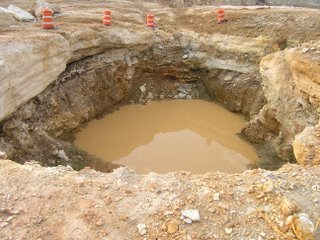More Trenchless Thoughts - Part VI
I've both seen and participated in a number of horizontal borings over the last 5 or 6 years that have allowed me to discern the nature of the relationship between knowing jobsite geology in advance and the success of the bore. Horizontal boring contractors, vendors, manufacturers, and those who administrate horizontal bores successfully have a saying:
Prior planning, including planning for possible or potential trouble, is an integral part of an overall successful job. Knowing the GEOLOGY, in the form of a geotechnical investigation, is an important part of the overall plan. I am of the belief that if you know the geology of the borepath you can choose which method of horizontal boring is best to use.
Here's an example:
A utility owner wants to install a 24-inch diameter steel pipe underneath a road (we know immediately that this job is going to be a horizontal bore, because it would cost too much in a DOT utility permit and repair to the road to do it open-cut) and gives this information to a contractor. From a preliminary site survey, the utilty's personnel have determined that there are no conflicting utilities in the path of the bore. What other important information (besides the plan specifications and site survey) should the utility owner be prepared to give the contractor?
The contractor should require, and the utility should be ready to provide, a geologic report of the location. This report should contain all of those geologic factors that will influence the overall success of the planned installation. These factors include the soil texture, consistency, water table depth, and other parameters as needed. An auger boring is possible if sand, silt, or clay is encountered. If cobbles or boulders are encountered that are greater than 1/3 the diameter of the bore (8" diameter in this case) auger boring may not be economical. Pipe ramming may need to be considered as an alternate method.
If any pits or accesses need to be constructed, their slope stability is also influenced by the soil type present. In addition, the soil strength should be considered as well, especially for the potential for settlement that would affect the overall line and grade of the boring.
These are just a few of the considerations that must be examined in detail by the geologic report. If you give the contractor a geologic report in advance of the job, expect your overall bid price to be lower because you're taking uncertainty out of the overall bid.
The National Utility Contractor's Association, or NUCA, sells a very useful text called "Trenchless Installation and Soil Compatibility Manual". See their website at http://www.nuca.org for more details.
Until next time,
Trenchless Geologist



